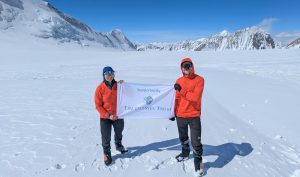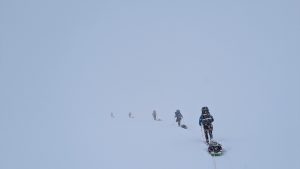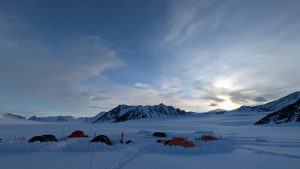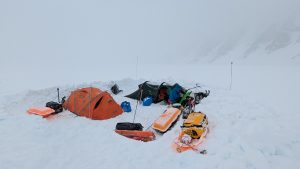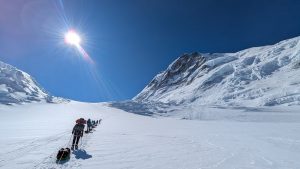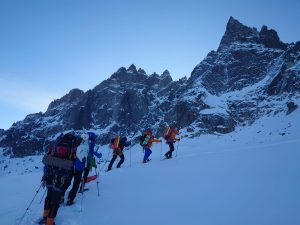“You can train for a storm in a textbook, but nothing prepares you for the reality of being inside a tent that feels like it’s about to be torn apart, thousands of miles from anywhere… You are completely reliant on the person next to you. That experience alone was worth the entire trip.” – LCpl Huynh.
Introduction: In May 2025, a 12-person team from across the British Army embarked on an ambitious expedition to the Saint Elias Mountains of the Yukon. The primary objective was to summit Mount Logan (5,959m), the highest peak in Canada. The broader aim was to test and develop courage, leadership, teamwork, and resilience in one of the world’s most extreme and remote cold-weather environments. While severe weather and logistical challenges ultimately prevented a summit, the expedition was a profound success, forcing the team to overcome immense adversity that forged character in a way no straightforward ascent ever could.
Preparation and Training
Recognising the scale of the challenge, the team undertook a rigorous, two-phase Mission Readiness Exercise. The first phase, at Carver Barracks in Essex, focused on foundational skills: servicing equipment and drilling complex medical protocols for altitude sickness and prolonged field care.
The second phase took the team to the glaciers above Chamonix in the French Alps. Here, theory was put into practice. The team mastered glacier travel, crevasse rescue with heavy pulks (sleds), and ran through realistic emergency scenarios. This training proved invaluable when a fierce, real-life gale ripped through their high camp, snapping tent poles and testing the team’s decision-making under pressure. This incident reinforced lessons that would become a defining theme of the main expedition.
The Expedition:
A Battle Against the Elements – The Waiting Game (Days 1-4):
From the moment we arrived in Canada, the expedition became a lesson in patience. A logistical crisis was narrowly averted when our entire supply of dehydrated meals was recovered from a closed courier depot on a national holiday. At the remote airhead, the waiting game began. For three days, poor weather on the mountain grounded all flights. The team’s morale and ability to manage frustration were tested early, with days spent reading, playing cards, and constantly preparing kit for a weather window that refused to open. On the fourth day, we finally began flying onto the glacier in rotations, with the full team finally united on the mountain by evening.
On the Mountain (Days 5-14): The challenges intensified immediately. A team member sustained an ankle injury on the first day of ascent, forcing a real-life casualty management situation and splitting the team. The advance party pushed on, only to be enveloped in a complete whiteout, navigating by rapidly disappearing ski tracks as the sound of distant avalanches served as a constant reminder of the volatile environment.
The expedition’s defining challenge arrived shortly after; a ferocious storm that pinned the advance team down at 3,300m for four full days. Winds gusting to 80km/h battered the tents, while relentless snowfall threatened to bury them completely. Survival became a cycle of waking every few hours, day and night, to dig out the tents in blizzard conditions.
When the storm finally broke, the team was exhausted but intact. Reunited with the team members who had been stuck lower on the mountain they continued to establish further camps up to 4200m before being faced with another forecast storm that again threatened progress. However, the accumulated delays and a subsequent case of frostbite to a team member’s finger forced the leaders to make the difficult but correct decision to abandon the summit attempt. The priority shifted from climbing to safely evacuating the casualty and ensuring the entire team returned unharmed. This mature and selfless decision-making in the face of immense personal and team disappointment was perhaps the expedition’s greatest achievement.
Extraction (Days 15-21): The journey ended as it began: with a multi-day, weather-enforced wait at Base Camp, battling logistical delays for a flight back to civilisation. The team’s resilience was tested right until the final members were flown off the ice.
Impact and Benefits: While we did not stand on the summit, the expedition fulfilled the core objectives of the Ulysses Trust in the most testing of circumstances. The constant adversity stripped away pretence and forged a team bound by shared hardship and absolute trust. Every member was pushed to their physical and mental limits, developing a profound understanding of their own capabilities.
For the unit and the participants, the benefits are clear. The expedition has returned a group of soldiers with an enhanced ability to operate under extreme pressure, to make critical decisions with incomplete information, and to persevere in the face of repeated setbacks. These are skills directly transferable to military operations. The experience has instilled a deep sense of self-reliance, adaptability, and an appreciation for meticulous planning.
The expedition was a powerful reminder that true success is not always measured by reaching a summit, but by the strength, character, and judgment forged in the attempt. We are immensely grateful to the Ulysses Trust for their support, which enabled an experience that has undoubtedly made us better soldiers and more resilient individuals.


